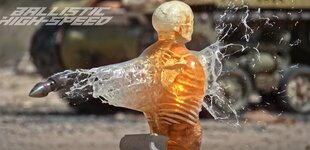gel picture
fbi example - what is given for info, impact velocity, 16" travel, finished diameter and weight, bunch of work along that travel represented visually by damage of various types
what I want to know is...
at the 7" mark what was the velocity, bullet weight, and sd...so from there we could see the work being transferred, and again what was it at the 8" mark, 9" mark???? and every damn inch of that travel, ie; what is the rate of bullet change in relation to the rate of work transferred, and more, where is the bulk of the workload along the travel, how much is that workload
what's the work transfer curve of that option? the dyno? what work output is it doing at this particular swim speed? or that swim speed? is it all at the front end where most useful? or do I need a linear option because the game is much larger than normal and need to get deeper as a 1st priority?
and I wanna see it at all useful impact velocities whether by doing every 200 fps and filling in the blanks from the deltas between and v-lookup tables feeding the outputs from the background etc....whatever it takes
we can't see any of that yet, but the info is there, we just need to learn how to get it
I hear those Garmin zero's are the sh1t...can they measure through gel? haha
we have only begun starting to ask the right questions on this

